Vector Control
- Huntington County
- Environmental Sanitarian
- Current: Vector Control
Coming Soon
Mosquito Bite Prevention
The best way to prevent mosquito-borne illnesses is to prevent the bites of infected mosquitoes. You can do this by taking measures to protect yourself from mosquito bites, taking steps to control mosquitoes indoors and outdoors, and supporting mosquito control programs in your community.
- Protecting Yourself From Mosquito Bites
- Know when to expect mosquito bites. The mosquitoes that transmit disease in Indiana usually bite during the hours from dusk to dawn.
- Wear EPA-registered insect repellents. The Environmental Protection Agency (EPA) recommends repellents containing DEET, picaridin, IR3535, oil of lemon eucalyptus, para-menthane-diol or 2-undecanone. Not all repellents are effective against both mosquitoes and ticks. The EPA’s helpful search tool can help you find the product that is best for you. Always follow product instructions:
- Do not use insect repellent on babies younger than 2 months old.
- Do not use products containing oil of lemon eucalyptus or para-menthane-diol on children younger than 3 years old.
- Treat your clothes and outdoor gear with 0.5% permethrin. Permethrin can be used to treat boots, clothing and camping gear and remains protective through several washings. Permethrin should never be applied directly to the skin.
- Reduce the amount of exposed skin. Wearing long sleeves, long pants, hats, socks and shoes that cover the entire foot will make it more difficult for mosquitoes to bite.
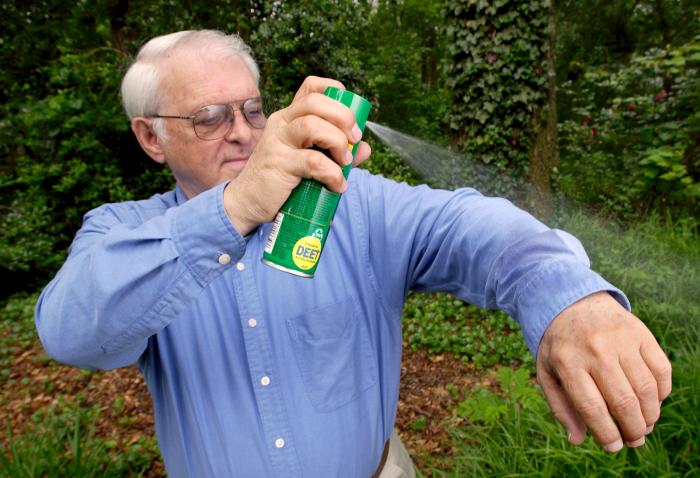
Taking Steps to Control Mosquitoes Indoors and Outdoors
- If possible, use air conditioning rather than leaving your doors and windows open.
- Use screens on windows and doors. Repair holes in screens to keep mosquitoes outdoors.
- Find and remove possible mosquito breeding sites around your home. Mosquitoes lay their eggs in standing water. Removing sources of standing water can reduce the number of mosquitoes around your property. This will protect you and your family as well as your neighbors:
- “Tip and toss:” Once a week, empty and scrub, turn over, cover, or throw out items that could collect water outdoors, such as tires, buckets, planters, toys, pools, birdbaths, flowerpots and trash containers.
- Tightly cover water storage containers (buckets, cisterns, rain barrels) so that mosquitoes cannot get inside to lay eggs.
- For containers without lids, use wire mesh with holes smaller than an adult mosquito.
- If you have a septic tank, repair any cracks or gaps. Cover open vents or plumbing pipes. Use wire mesh with holes smaller than an adult mosquito.
Supporting Mosquito Control Programs in Your Community
- Community mosquito control programs can help to reduce the number of mosquitoes and prevent mosquito-borne diseases in your neighborhood.
- Community mosquito control activities may include elimination of mosquito habitats, application of insecticides to bodies of water to kill mosquito larvae and spraying of insecticides from trucks to kill adult mosquitoes.
- Mosquito control activities are most often handled at the local level, such as through county or city government.
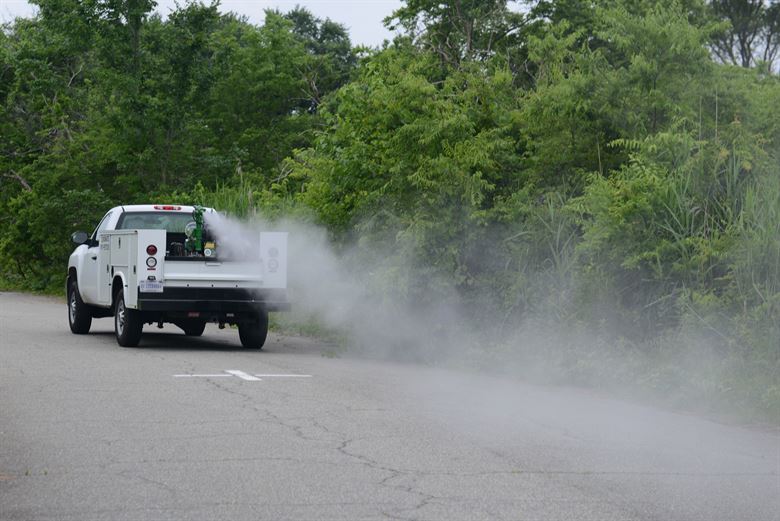
For More information and to view a detailed dashboard for our community visit the Indiana Department of Health.
The best way to prevent tick-borne illnesses is to prevent the bites of infected ticks. You can do this by avoiding tick habitats, using personal protection methods, and changing the environment to reduce the presence of ticks.
- Before you go outside
- Know where to expect ticks. Spending time in grassy, brushy, or wooded areas could expose you to ticks. This could include walking your dog, gardening, playing outside, hiking, camping, hunting, or other outdoor activities. Many people get tick bites in their own backyards or neighborhoods.
- Treat your clothes and outdoor gear with 0.5% permethrin. Permethrin can be used to treat boots, clothing, and camping gear and remains protective through several washings. Permethrin should never be applied directly to the skin.
- Wear EPA-registered insect repellents. The Environmental Protection Agency (EPA) recommends repellents containing DEET, picaridin, IR3535, oil of lemon eucalyptus, para-menthane-diol, or 2-undecanone. Not all repellents are effective against both mosquitoes and ticks. EPA’s helpful search tool can help you find the product that is best for you. Always follow product instructions.
- Do not use insect repellent on babies younger than 2 months old.
- Do not use products containing oil of lemon eucalyptus or para-menthane-diol on children younger than 3 years old.
- Reduce the amount of exposed skin. Wearing long sleeves, long pants, hats, socks, and shoes that cover the entire foot will reduce the chance that a tick will be able to attach. Tucking in your shirt and stuffing your pant legs inside the tops of your socks is also recommended. Wearing light-colored clothing may make ticks easier to see and remove.
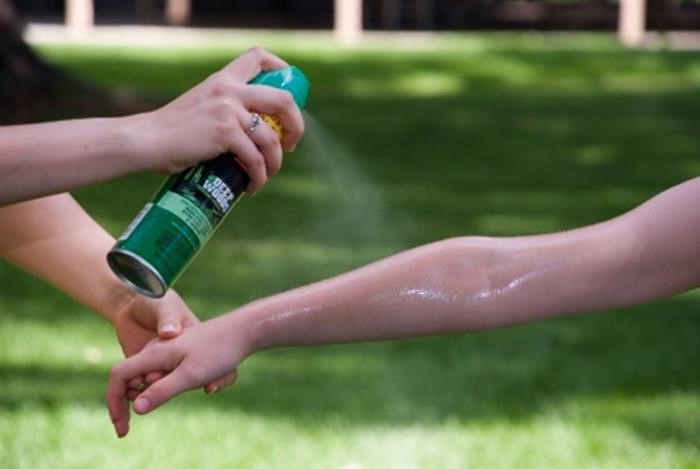
- Reapply insect repellent according to the product instructions.
- Avoid grassy, brushy, or wooded areas when possible.
- Walk in the center of marked trails in order to avoid brushing against tall grass and plants.
- Check clothing and skin frequently for ticks.
- Dry your clothing to kill ticks. Unattached ticks may be carried into the house on clothing. Immediately disrobing and tumbling dry clothes in a dryer on high heat for 20 minutes is recommended to kill ticks. If the clothes are damp, additional time may be needed. When washing, hot water is recommended because cold or warm water will not kill ticks.
- Shower soon after being outdoors. Showering within two hours of coming indoors has been shown to reduce your risk of getting Lyme disease and may be effective in reducing the risk of other tickborne diseases. Showering may help wash off unattached ticks and it is a good opportunity to do a tick check.
- Check your body for ticks soon after being outdoors. Conduct a full body check upon return from potentially tick-infested areas, including your own backyard. Immature ticks are much smaller than adults and can be no larger than a poppy seed. Use a hand-held or full-length mirror to view all parts of your body. Check these parts of your body and your child’s body for ticks:
- In and around the hair
- In and around the ears
- Under the arms
- Around the waist
- Inside belly button
- Between the legs
- Back of the knees
- Examine gear and pets for ticks. Ticks can ride into the home on clothing and pets, then attach to a person later, so carefully examine pets, coats, and daypacks.
- Use fine-tipped tweezers or a tick removal tool to grasp the tick as close to the skin’s surface as possible.
- Pull upward with steady, even pressure. Don’t twist or jerk the tick; this can cause the mouth-parts to break off and remain in the skin. If this happens, remove the mouth-parts with tweezers. If you are unable to remove mouth parts easily with clean tweezers, leave the area alone and let the skin heal.
- After removing the tick, thoroughly clean the bite area and your hands with rubbing alcohol or soap and water.
- Never crush a tick with your fingers. Dispose of a live tick by putting it in alcohol, placing it in a sealed bag/container, wrapping it tightly in tape, or flushing it down the toilet.
- What to do if you feel sick
Not everyone who develops a tick-borne illness remembers having a tick bite. If you develop a rash or fever within several weeks of outdoor activity, see your health care provider. Be sure to tell him or her about the nature of your outdoor exposures at home and during travel.
are provider. Be sure to tell him or her about the nature of your outdoor exposures at home and during travel.
- How to reduce ticks in your yard
While it is not possible to eliminate ticks from grassy, brushy, or woody areas, there are steps you can take to reduce the number of ticks in your yard, including:
- Promptly remove dead leaves.
- Clear tall grasses and brush around homes and at the edge of lawns.
- Place a three-foot wide barrier of wood chips or gravel between lawns and wooded areas to restrict tick migration into recreational areas.
- Mow the lawn frequently.
- Stack wood neatly and in a dry area to discourage rodents.
- Keep playground equipment, decks, and patios away from yard edges and trees.
- Construct fences to discourage unwelcome animals (such as deer, raccoons, and stray dogs) from entering your yard.
- Remove old furniture, mattresses, or trash from the yard that may give ticks a place to hide.
In severe cases, a single application of insecticide can be effective in reducing ticks on the lawn or in other outdoor areas. Consult with a licensed pesticide applicator before taking this step.
Dogs are susceptible to tick bites and tick-borne diseases. Dogs and cats can also bring unattached ticks into your home, placing you at risk for tick bites even if you have not spent any time outdoors. For these reasons, it’s important to use a tick prevention product on your pets.
Talk to your veterinarian about:
- How tick-borne illnesses could affect your pets’ health
- The best tick prevention products for your pets
To further reduce the chances that a tick bite will make your pet sick:
- Check your pets for ticks daily, especially after they spend time outdoors.
- If you find a tick on your pet, remove it right away.
- Reduce tick habitats in your yard.
Note: Cats are extremely sensitive to a variety of chemicals. Do not apply tick prevention products to your cats without first consulting with your veterinarian.
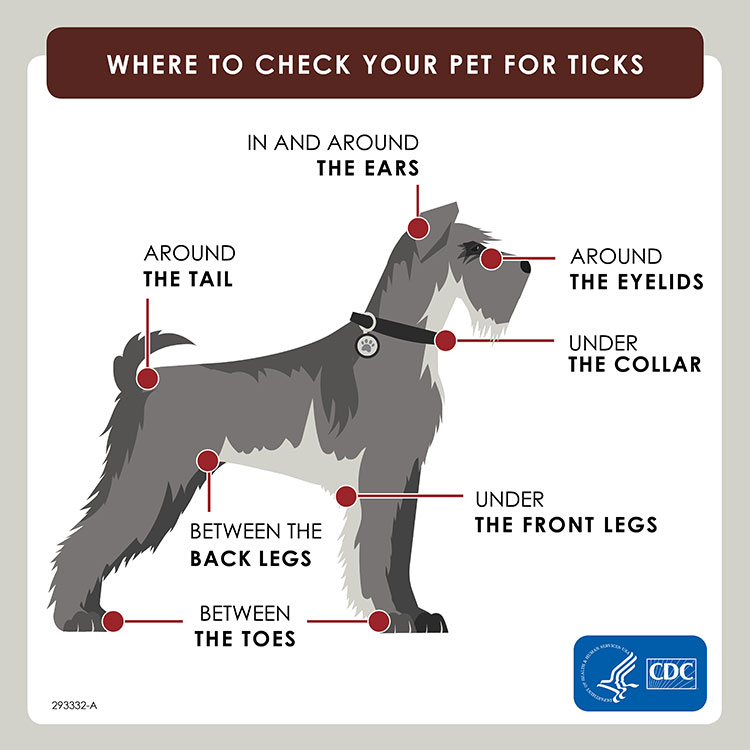
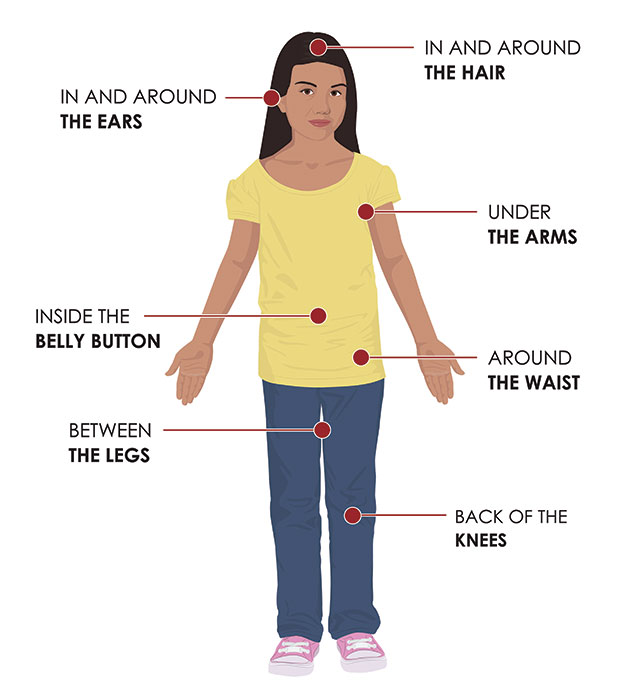
How to remove an attached tick
DO NOT use remedies such as “painting” the tick with nail polish or petroleum jelly or using heat to make the tick detach from the skin. Your goal is to remove the tick as quickly as possible–not wait for it to detach. Here’s how to safely and quickly remove a tick:
Information
Bed bugs, Cimex lectularius, are reddish-brown, oval-shaped, flattened insects that are about 1/4 inch long. Nymphs (immature bed bugs) resemble adult bugs but are often smaller and lighter in color. Bed bugs usually feed on the blood of humans during the nighttime hours and crawl away to hide in nearby cracks, crevices and recesses of furniture (especially mattresses) and walls of the home during the day. Many people experience itching, pain and/or swelling of the skin where a bed bug bite occurs (such as the arms, face or back) within 1 day of a bite. Although the bites can cause considerable discomfort and loss of sleep, bed bugs do not transmit disease after feeding on multiple hosts.
What are bed bugs?
Bed bugs (Cimex lectularius) are small, flat, parasitic insects that feed solely on the blood of people and animals while they sleep. Bed bugs are reddish-brown in color, wingless, range from 1mm to 7mm (roughly the size of Lincoln’s head on a penny), and can live several months without a blood meal.
Where are bed bugs found?
Bed bugs are found across the globe from North and South America, to Africa, Asia and Europe. Although the presence of bed bugs has traditionally been seen as a problem in developing countries, it has recently been spreading rapidly in parts of the United States, Canada, the United Kingdom, and other parts of Europe. Bed bugs have been found in five-star hotels and resorts and their presence is not determined by the cleanliness of the living conditions where they are found.
Bed bug infestations usually occur around or near the areas where people sleep. These areas include apartments, shelters, rooming houses, hotels, cruise ships, buses, trains, and dorm rooms. They hide during the day in places such as seams of mattresses, box springs, bed frames, headboards, dresser tables, inside cracks or crevices, behind wallpaper, or any other clutter or objects around a bed. Bed bugs have been shown to be able to travel over 100 feet in a night but tend to live within 8 feet of where people sleep.
Do bed bugs spread disease?
Bed bugs are not known to spread disease. Bed bugs can be an annoyance because their presence may cause itching and loss of sleep. Sometimes the itching can lead to excessive scratching that can sometimes increase the chance of a secondary skin infection.
What health risks do bed bugs pose?
A bed bug bite affects each person differently. Bite responses can range from an absence of any physical signs of the bite, to a small bite mark, to a serious allergic reaction. Bed bugs are not considered to be dangerous; however, an allergic reaction to several bites may need medical attention.
What are the signs and symptoms of a bed bug infestation?
One of the easiest ways to identify a bed bug infestation is by the tell-tale bite marks on the face, neck, arms, hands, or any other body parts while sleeping. However, these bite marks may take as long as 14 days to develop in some people so it is important to look for other clues when determining if bed bugs have infested an area. These signs include:
- the bed bugs’ exoskeletons after molting,
- bed bugs in the fold of mattresses and sheets,
- rusty–colored blood spots due to their blood-filled fecal material that they excrete on the mattress or nearby furniture, and
- a sweet musty odor.
How do I know if I’ve been bitten by a bed bug?
It is hard to tell if you’ve been bitten by a bed bug unless you find bed bugs or signs of infestation. When bed bugs bite, they inject an anesthetic and an anticoagulant that prevents a person from realizing they are being bitten. Most people do not realize they have been bitten until bite marks appear anywhere from one to several days after the initial bite. The bite marks are similar to that of a mosquito or a flea — a slightly swollen and red area that may itch and be irritating. The bite marks may be random or appear in a straight line. Other symptoms of bed bug bites include insomnia, anxiety, and skin problems that arise from profuse scratching of the bites.
Because bed bug bites affect everyone differently, some people may have no reaction and will not develop bite marks or any other visible signs of being bitten. Other people may be allergic to the bed bugs and can react adversely to the bites. These allergic symptoms can include enlarged bite marks, painful swellings at the bite site, and, on rare occasions, anaphylaxis.
How did I get bed bugs?
Bed bugs are experts at hiding. Their slim flat bodies allow them to fit into the smallest of spaces and stay there for long periods of time, even without a blood meal. Bed bugs are usually transported from place to place as people travel. The bed bugs travel in the seams and folds of luggage, overnight bags, folded clothes, bedding, furniture, and anywhere else where they can hide. Most people do not realize they are transporting stow-away bed bugs as they travel from location to location, infecting areas as they travel.
Who is at risk for getting bed bugs?
Everyone is at risk for getting bed bugs when visiting an infected area. However, anyone who travels frequently and shares living and sleeping quarters where other people have previously slept has a higher risk of being bitten and or spreading a bed bug infestation.
How are bed bugs treated and prevented?
Bed bug bites usually do not pose a serious medical threat. The best way to treat a bite is to avoid scratching the area and apply antiseptic creams or lotions and take an antihistamine. Bed bug infestations are commonly treated by insecticide spraying. If you suspect that you have an infestation, contact your landlord or professional pest control company that is experienced with treating bed bugs. The best way to prevent bed bugs is regular inspection for the signs of an infestation.
Huntington County Health Department
Contact Information
1330 S Jefferson St
Huntington, IN 46750
Phone: (260) 358-4831
Fax: (260) 358-4899
Contact Us
Other Information
8 a.m. to 4:30 p.m.
Monday through Friday
Closed daily for lunch 11:45 a.m. to 12:45 p.m.
*To report a public health or environmental emergency after business hours, please call 911.




